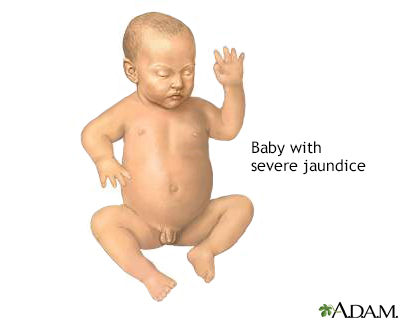Pregnancy SmartSiteTM
Jaundice of the newborn - discharge; Neonatal hyperbilirubinemia - discharge; Breastfeeding jaundice - discharge; Physiologic jaundice - discharge DefinitionYour baby has been treated in the hospital for newborn jaundice. This article tells you what you need to know when your baby comes home. When Your Child Was in the HospitalYour baby has newborn jaundice. This common condition is caused by high levels of bilirubin in the blood. Your child's skin and sclera (whites of their eyes) will look yellow. Some newborns need to be treated before they leave the hospital. Others may need to go back to the hospital when they are a few days old. Treatment in the hospital most often lasts 1 to 2 days. Your child needs treatment when their bilirubin level is too high or rising too quickly. To help break down the bilirubin, your child will be placed under bright lights (phototherapy) in a warm, enclosed bed. The infant will wear only a diaper and special eye shades. Your baby may have an intravenous (IV) line to give them fluids. Rarely, your baby may need treatment called a double volume blood exchange transfusion. This is used when the baby's bilirubin level is very high. Unless there are other problems, your child will be able to feed (by breast or bottle) normally. Your child should feed every 2 to 2 ½ hours (10 to 12 times a day). The health care provider may stop phototherapy and send your child home when their bilirubin level is low enough to be safe. Your child's bilirubin level will need to be checked in the provider's office, 24 hours after therapy stops, to make sure the level is not rising again. Possible side effects of phototherapy are watery diarrhea, dehydration, and skin rash that will go away once the therapy stops. What to Expect at HomeIf your child did not have jaundice at birth but now has it, you should call your provider. Bilirubin levels are generally the highest when a newborn is 3 to 5 days old. Many web-based applications can quickly detect bilirubin levels in newborns without requiring blood tests. These applications use a cellphone camera and a color card to check bilirubin levels. These applications can help parents monitor the bilirubin levels of their newborn at home and seek immediate care if necessary. If the bilirubin level is not too high or not rising quickly, you can do phototherapy at home with a fiber optic blanket, which has tiny bright lights in it. You may also use a bed that shines light up from the mattress. A nurse will come to your home to teach you how to use the blanket or bed and to check on your child. The nurse will return daily to check your child's:
You must keep the light therapy on your child's skin and feed your child every 2 to 3 hours (10 to 12 times a day). Feeding prevents dehydration and helps bilirubin leave the body. Therapy will continue until your baby's bilirubin level lowers enough to be safe. Your baby's provider will want to check the level again in 2 to 3 days. If you are having trouble breastfeeding, contact a breastfeeding nurse specialist or lactation consultant. When to Call the DoctorContact your baby's provider if the infant:
Also contact your baby's provider if you have concerns, if the jaundice is getting worse, or the baby:
ReferencesBiliTool TM website. bilitool.org. Updated May 2024. Accessed April 7, 2025. Kaplan M, Wong RJ, Bensen R, Sibley E, Stevenson DK. Neonatal jaundice and liver diseases. In: Martin RJ, Fanaroff AA, eds. Fanaroff and Martin's Neonatal-Perinatal Medicine. 12th ed. Philadelphia, PA: Elsevier; 2025:chap 95. Kliegman RM. Digestive system disorders. In: Kliegman RM, St. Geme JW, Blum NJ, et al, eds. Nelson Textbook of Pediatrics. 22nd ed. Philadelphia, PA: Elsevier; 2025:chap 134. Rozance PJ, Wright CJ. The neonate. In: Landon MB, Galan HL, Jauniaux ERM, et al, eds. Gabbe's Obstetrics: Normal and Problem Pregnancies. 9th ed. Philadelphia, PA: Elsevier; 2025:chap 25. | ||
| ||
Review Date: 1/17/2025 Reviewed By: Charles I. Schwartz, MD, FAAP, Clinical Assistant Professor of Pediatrics, Perelman School of Medicine at the University of Pennsylvania, General Pediatrician at PennCare for Kids, Phoenixville, PA. Also reviewed by David C. Dugdale, MD, Medical Director, Brenda Conaway, Editorial Director, and the A.D.A.M. Editorial team. View References The information provided herein should not be used during any medical emergency or for the diagnosis or treatment of any medical condition. A licensed medical professional should be consulted for diagnosis and treatment of any and all medical conditions. Links to other sites are provided for information only -- they do not constitute endorsements of those other sites. No warranty of any kind, either expressed or implied, is made as to the accuracy, reliability, timeliness, or correctness of any translations made by a third-party service of the information provided herein into any other language. © 1997- A.D.A.M., a business unit of Ebix, Inc. Any duplication or distribution of the information contained herein is strictly prohibited. | ||


 Infant jaundice
Infant jaundice
